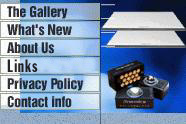
 |
 |
Technology |

 |
|
 |
Isolation Drainage Svelte Technology
Technology: A Discussion About Vibration Control
How can mechanical vibration cause electronic signal distortion?
By moving the parts inside of an electronic component, relative to one another or relative to electric fields. This movement of conductive elements causes secondary, distorted signals to be induced in the same circuitry which is processing the primary signal.Exactly how does this happen?
Through the interaction of electric and magnetic fields.Back up a minute. You're trying to tell me that physical motion affects electronic signals?
Yes. It's the basis of the entire science and industry of sound, and is the reason why loudspeakers work. A dynamic cone loudspeaker diaphragm moves because of the interaction of electric currents and a magnetic field. The reverse is equally true: by moving a wire through a magnetic field, you induce a current in it. That's called a generator, and that's how we get our electricity. Vibration in components is a type of motion that causes distortion through the movement of electric conductors, and the magnetic fields which all these conductors generate,with respect to one another.This sounds like snake oil. How does this happen, exactly, and what is the scientific basis for it?
No snake oil here - just plain physics. When electricity passes through a wire, magnetic, electric and electrostatic fields are generated around the wire. These fields are similar to the pattern you see when you shake iron filings around a magnet, except that they constantly change with the changing electric current. These fields expand and contract with the electrical signal.So?
So now, let's assume you've got a second wire which is close to the first one. It can be connected or unconnected to that first wire: it doesn't matter. Now, let's say the first wire has a current going through it, and so, a magnetic field is being generated by this wire. This magnetic field expands in the space around the first wire, intersecting with and cutting through the second wire. And now, an interesting thing happens. A new current is induced in the second wire. This new current in the second wire will be an exact (though much weaker) replica of the first one which created the field, as long as the two wires don't move relative to one another while the current is passing through.What you're saying is that all electronic circuits have tiny "echoes" in them.
That's right. But if these "echoes" are exact replicas of the original signal, they are in essence undetectable for the most part, since it's like painting the same color on top of a color.What happens if the two wires move?
There's the rub. If the wires move, then amplitude and phase of the induced signal will change or be "modulated" by the movement of the first wire. Thus, you get a different signal on top of the signal you're trying to reproduce - or more precisely, a distorted version of it, and that IS detectable!Almost everyone has tried writing or drawing while riding on a bus, in a car, or some other vehicle, and you know that you need a smooth ride if you're going to have any chance of doing a good job! If the car goes over a bump, that bump is usually tranferred to your writing - and makes a distinct and unwanted "change" in your picture or handwriting! The same analogy can be used here with vibration in electrical circuits. As vibration causes the wires to move closer and further away, the intensity and even the frequency of the induced secondary pattern changes, and the secondary "drawing" becomes more and more unrecognizable - more distorted. It is like the reflection in an otherwise placid pool of water when complex waves run over the surface, causing distortion of the reflected image. In an analogous manner, the movement of the wires relative to one another causes the secondary induced current to be a distorted "image" of the primary signal current.
But this secondary "echo" is so tiny. How could it possibly be a problem?
Look inside any modern component. There are literally thousands of signal paths. An integrated circuit can have millions of parts and wires on one tiny chip! Also, their size is microscopic - which means that correspondingly microscopic vibrations begin to be big compared to one of these tiny circuit elements. Now, when you multiply even a vanishingly tiny amount of distortion by millions of parts, you begin to get a signal which can be an appreciable percentage of the original signal - which is ultimately amplified millions of times. This distortion can then ultimately be "heard" as part of the final signal when reproduced through loudspeakers - or seen, if we're talking about video circuits.So how do you get rid of this vibration?
Short of rebuilding the entire component part by part, you can't. However, there is an alternative: we can manage it. And we do that by providing an escape route for this unwanted energy, to at least drain the lion's share of it away.I've never heard of this before. Has anyone ever done this?
Of course. The first very practical accessory that dealt directly with vibration drainage was the cone. Symposium Rollerblocks do some of the same things that a cone does, but with a few new tricks. And then, of course, there are our "energy absorption platforms," which are able to drain energy away from component chassis effectively, and dissipate much of it as heat.You're not mentioning the other products out there!
Oops! Yes, there are plenty of them now, and more coming along every day. When Symposium began experimenting with vibration control in 1992, there was very little beyond granite blocks to buy in terms of component and speaker platforms. We like to think that we had something to do with the great proliferation of vibration platforms and devices since then, but perhaps we're being a little too self-congratulatory. At any rate, "Isolation" as it is called, and this is misleading term, because isolation is only part of the answer, has finally become popular in the last decade, and recognized for its vital importance in sound reproduction. Although there were designers interested in the problem earlier than that, it seems that only recently has there been serious attention paid to it. This is a similar situation to "wire" issues- back in the 70's, for instance, even though high end audio was experiencing a Renaissance, almost nobody (with few exceptions) knew that wire could make a difference in the performance of an audio system- or why.Why is Vibration Control becoming popular now?
We think it's primarily due to two reasons: first, and most important, is the fact that audio and video systems have taken a giant leap forward in transparency and performance potential in the last 20 years. The second reason is that, because of the advance of technology and the general improvement in sound system resolution, we can now more clearly hear (and see!) the effects of vibration control, whereas two decades ago, these effects were "masked" by overlapping and compounding problems in the rest of the system.Has this happened because of the Compact Disc?
No, this has happened in spite of the compact disc! We think that the main factor which has been responsible for improvements, other than the very strong and dedicated audiophile community of designers and enthusiasts, has been the personal computer. It's now possible for almost anyone to have more computing power that was once only available to a very small number of privileged people. This change has impacted all aspects of life, and the audiophile community is not exempt. In particular, loudspeaker design has become far more of a precise science since the breakthrough work of people like A. N. Thiele of Australia in the early 60s. His brilliant work, which described that a loudspeaker cabinet could be modeled as, in essence, nothing more or less than a mechanical high pass filter, enabled vented box or "bass reflex" speaker design to come out of the darkness. Suddenly, "bass reflex" speakers were no longer guesswork- they were now a precise science. Today, anyone with a PC and a few hundred dollars can derive precise box and vent dimensions for virtually any dynamic woofer in a matter of seconds! Before A. N. Thiele, vented bass loudspeaker systems varied wildly and almost randomly in terms of their frequency response and time domain performance. Now, they are much more alike in these important aspects of reproducing a wavefront accurately, and this, in turn, has enabled other technologies to emerge.You made a comment above about CDs. Are you against digital or something?
Absolutely not! We just want to note that the very first CD players were... well... awful sounding. How bad were they? Some people got headaches. These problems were aspects of a new process which, like all new things, needed to be perfected. Today, however, digital technology is far better, and thankfully, there really isn't too much to compare to those first digital systems.More to come....
Home | Products | Our Technology | Reviews | Dealers | F A Q | Set Up Tips | The Gallery | What's New | About Us | Links | Privacy Policy | Contact Info
Copyright © 2002 Symposium USA, Inc. All Rights Reserved